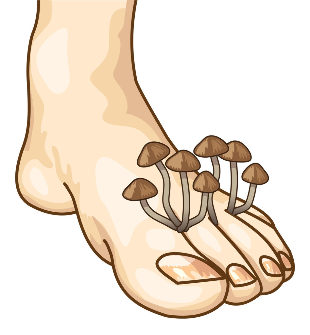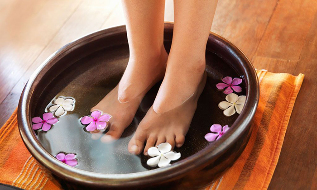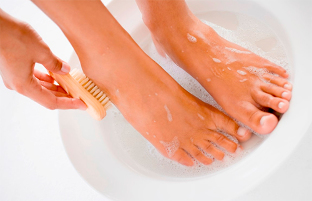Yeast infection is the a lot of frequently affects the toes or fingernails. This disease affects both adults and children. In order to avoid the transmission of the disease in a chronic form, it is necessary to know the signs of foot fungus, and how does such a disease.

The main symptoms of the disease
Among all the skin diseases, athlete's foot is the most common. To a disease, and ignoring the elementary rules of hygiene. To cure the fungus can sometimes be very difficult.
Every single person has foot fungus it begins and develops in their own way. Here are the most common signs that you can recognize athlete's foot:
- between the fingers there are the typical cracks;
- to understand that there is a fungus that can be a characteristic rash of the feet and between the toes;
- the skin is very dry, often scaly, and rough;
- between the toes blisters, which burst in the destruction;
- the infection can pass to the neighboring areas;
- the skin appear reddish spots that cause severe discomfort;
- learn the foot fungus you may have unpleasant odor.
Signs of the fungus, depending on the type of pathogen
This disease develops due to a variety of different types of pathogens. The signs and symptoms of the legs will differ in each case.
- If the foot develops a yeast fungus in the nail gradually becomes thinner and pulls away from the bed. The skin of the hyperaemic (becomes tinged with red).
- With the growth of the fungus in the nail is turning yellow, covered with dots. The skin on his feet peels off, it emits an unpleasant odor. The characteristic symptoms of this type of fungus is to increase the dryness of your skin.
- The occurrence of mould fungi in the nail plate can change its color. The skin becomes red, if the pathogen pathology is gradually moving to the whole foot. A man worried about the itching, the skin can crack. In this case, during the time of the walk, there is pain and other discomfort.
To determine the type of the pathogen can only be a doctor. At home, it can be done. And, if you practice self-care, you can only hurt yourself. You will suffer from it the foot, and the skin, the fungus will spread to more and more and more and more.
The characters of some of the forms of the fungus
Depending on the affected area and the level of development, there are a couple of forms of the pathology. The signs and symptoms of each are different. Awareness of the early signs of the disease, the legs, such as the beginning of the treatment of mycosis.
- Interdigital Dermatophyte is the most common disease. It aktiviziruyutsya in the spring and summer, when your feet sweat the most. Between the toes fractures and wounds. It is possible to notice the presence of scales on their skin. The foot looks perfectly healthy. Often the person feels itching.
- Your form appears in the least marked degree. Between the toes is slightly peeling. At this stage of the disease is from the feet are applied to the a sharp smell that emerged as a result of the increased activity of the bacteria.
The disease can occur in a variety of ways. Take a look at their features to know how to identify fungus on the feet, and in the case of its development, beginning with the treatment. You have to remember that in the advanced stages of the disease, the nail is completely destroyed. On the return, it is almost impossible.

Buzz type
For this fungus is characterized by an intense exfoliation of the epidermis. The most extensively affected is the skin between your toes or on the balls of your feet. The signs of the inflammatory process is absent. The image of the first signs of a foot fungus are visible areas of hyperemia. Scaly fungus looks like this:
- thickened stratum corneum;
- the skin is shiny, it sometimes becomes thick;
- the pattern of the skin becomes distinct;
- the fungus is gradually spreading to the toes, whole foot, affected nails;
- sometimes, the epidermis appears lamellar scales;
- other discomfort the patient is feeling.
A chronic type of
When this fungus appears on the skin, small blisters filled with fluid. Usually they are in the lateral part of the foot. Then, they gradually move toward the inner side of the fingers. How to recognize a fungus chronic:
- the balloon is generally solitary, but if a lot of them, they blend in to one big;
- if left untreated the fluid in the vesicles gradually darkens;
- if a blister ruptures, it appears the erosion crust.
Intertriginous type,
This type of fungus is the most common. At first the man did not feel any of the symptoms. Up to a certain point, the skin on your fingers doesn't change that. Further cracks, splits. The skin is not affected, but it can work.
The incidence of athlete's foot
The characteristic symptoms of this fungal infection as follows:
- the lesion is on the 3rd or the 4th toe;
- the skin is red and swollen;
- surrounding the lesion is a vesicle, where there is a detached layer of the skin;
- in the vicinity are the pustules that bubbles.
Signs of a fungal nail
A person may be affected, and the nails of the feet. To distinguish the disease by the following symptoms.
- Create a new profile to change the color of the nail plate. Depending on the type of pathology on a patient's nails to be acquired with a variety of colors. Sometimes it can be just a part of the nail plate.
- It breaks down the nail. It is only in the advanced stages of development. If the toenails are fully infected, it is ruined.
- Changes in the structure of the nail.
There are several types of onychomycosis — fungal nails.
- Atrophic appearance. The nail plate seems very thin. It darkens, and sometimes it becomes grayish-brown color. The nail is gradually peeled from the bed. The skin under it becomes rough and loose.
- When normotroficheskie type of fungus of the foot plate is changed to its color. Her videos appeared, a white, a yellow, a green, and even black. The structure of the nail does not suffer.
- In hypertrophic, ice gradually thickens, and becomes porous. The affected area looks very ugly, and, in some cases, the cause of the pain when walking. The parties shall crumble and die without treatment.

Some of the types of onychomycosis
Depending on the prevalence of the disease make a difference these forms.
- Lateral onychomycosis is the most common. The free edge of the nail appearing, the first a small yellow spot. In the future, you will be able to see how it gets larger, and the nail plate thickens. While walking, the person feels discomfort. No significant odor. Lateral onychomycosis is difficult to treat.
- Superficial onychomycosis is characterized by involvement of only the upper layers of the plate. It is not thickened, but in the end, it becomes like a crayon.
- The most rare form of the disease is a subungual onychomycosis. The skin is visibly thickened in the nail fold. The nail turns white and loses its transparency.
Risk group
In fact, the "capture" of the fungus you are taking a risk anywhere, even at home. However, in the general public, it is, of course, the odds are a lot higher (if you are not careful).
Who is at risk?
More likely to catch the fungus in the risk of the persons with the following diseases:
- Flatfoot and talipes.
- Under the influence of the flow of blood to the.
- Excessive sweating of the feet. Often the fungus get a grip on the athletes, and the military, which, because of the nature of the work, you need to go in tight or uncomfortable shoes, even in the heat.
- The presence of corns on the feet, as well as the men, with rough and thick skin on the feet.
- A weak immune system.
- In the presence of a chronic disease.
- A common injury to the skin around your nail or to the nail plates themselves. This category can be attributed to the fans of the pedicure in the area, or the people who ignore the rules of hygiene.
- Diabetes.
The basic principles for the treatment of
Each treatment begins with a diagnosis. Only then can it be assigned to the appropriate resources. Self-medication usually leads to the worsening of the feet. Take a look at the most common methods of treatment.
- At the first sign of a fungal infection apply a special varnish, plasters, ointments, and sprays. They are supposed to be used for a long time, and in accordance with the directions.
- The ineffectiveness of local treatment administered antifungal drugs with a complex action. They are to be used orally.
- Surgical removal of the affected nail.
- Laser therapy for.
- When the advanced form of the disease, it is prescribed systemic medications.
In order to avoid the nasty conditions, follow the rules of hygiene. You need to avoid the use of other people's personal hygiene needs (towels, Slippers). When the first signs of the disease should immediately consult a physician.
10 of the best folk remedies for nail fungus

If you suspect that your nail fungus at the same time as the treatment is necessary, it can be applied to one of the traditional methods. It is not recommended in lieu of treatment by a doctor— you risk to aggravate the problem and then the healing process will indeed be long and exhausting.
So, what are the tools came to us from our grandmothers and great-grandmothers?
- A treatment of the nails, and one of the following: propolis tincture, antiseptic oil, tea tree oil, apple cider vinegar.
- For a foot bath.You can also use sea salt, preferably without additives), the infusion of celandine, yarrow, Hypericum, oak bark, chamomile, calendula, and so on. After the bath you need to lubricate the nails with the juice of a lemon, iodine or apple cider vinegar.
- Iodine. The nature of the treatment: twice a day apply it on the damaged nails (over 20 days) 1 or 2 drops of iodine. If it's a successful treatment, and then go back to 1 every 3 days.
- Kombucha. Its infusion is used as a compresses. It is sufficient to impregnate the gauze, apply a compress and leave on overnight under a plastic, and the stockings. It can also be applied directly to a portion of tea fungus of the toenails, after which they need to get a bandage and leave for a couple of hours. Then, steam the feet and apply a mixture of apple cider vinegar (part 1), alcohol 96% (in 2 parts), glycerin (2 parts). About to leave for the night. The course of treatment — 2 weeks.
- The garlic oil.Pour the grated garlic in the hot sunflower oil, to completely cover the garlic. All mix, cover and insist 2 days. The nature of the treatment: wetted swab into the oil to be applied on the affected area, put a bandage secured to the top with a polythene, put on socks and leave it overnight. The course is 2 weeks long.
- Vinegar.Wetted swab in vinegar (9%), which is applied to the affected area, wrap with plastic, fix it with a bandage and leave over night. In the morning we repeat.
- Baking with the celandine. Increase your feet in a solution (3 liters of water + 1 tbsp/l of sodium), the legs, the affected area together with your fingers, oil, celandine (take a look at the drugstore). The course is 2 weeks long.
- Birch tar. To your feet with the use of the household/Soaps (about 20 minutes), the cleaning of the feet with a pumice stone, the cutting of a fingernail, a dry erase our legs, and lubricates the nail with your fingers, birch tar. Put your feet in it for 1.5 hours and read a book. Next, remove any excess tar with a bandage, wear cotton socks and be sure on your feet for a couple of days ago. At the end of my legs again, with khoz/the soap into the cold water. In the evening repeat the procedure. The course is 2 weeks long.
- Kalanchoe. Treatment of unpainted nail glue the spots on the leaves of the Kalanchoe to cover the nail holes. The stain upon the leaves change on a daily basis. Course — 2-3 weeks.
Prevention of nail fungus
To protect yourself from fungi, it can be easy to ensure compliance with the rules of hygiene and preventive measures.
Remember:

- In all the public areas, beaches, shower, locker room, pool, Spa-salons, etc.). bring washable Slippers. Do not walk barefoot where there is a risk of getting an infection!
- Do not wear other people's shoes (including Slippers the far — better-is walking around in socks).
- I don't use other people's towels, and manicure items.
- Getting out of the shower, put my legs in General (and it is often wet, and it is not the first freshness) on the Mat and your own towel (pre-set for just such a purpose).
- Regularly inspect the feet and the nails of the subject matter of the signs of the fungus. At the very least your symptoms (it had a cracking/scratching, between the fingers, change the color of the nails, etc.). action. That is, to get the ointment, a special/good luck, etc.
- You have to use a narrow, tight shoes and shoes made from poor quality materials.
- Regularly treat your boots inside and antiseptics.
- The feet don't sweat, use deodorants, talc, etc.
- Use only cotton socks. If you would like to use a tights/stocking (production of nylon and other synthetic fibers) to make sure that you remove them at home, until my legs worked.
- In the heat you wear open shoes for air ventilation and free air exchange. Sweaty feet — breeding ground for the bacteria.
- Don't measure for shoes with no socks/footprints— barefoot.
- Keep your feet dry after the bath including between your toes — that's where the fungus starts.
- Don't allow cracks on feet use a cream.
- My legs antibacterial mild soap.
- The high risk of infection (for example, on holiday or at the swimming pool), apply antifungal cream, powder or spray.
- Thoroughly dry the shoes, if it got wet. Put on wet shoes/boots.
- Just select a proven area for a pedicure/manicure.
- Do not allow the ingrowth, and the nail deformation — measures in a timely manner.





























